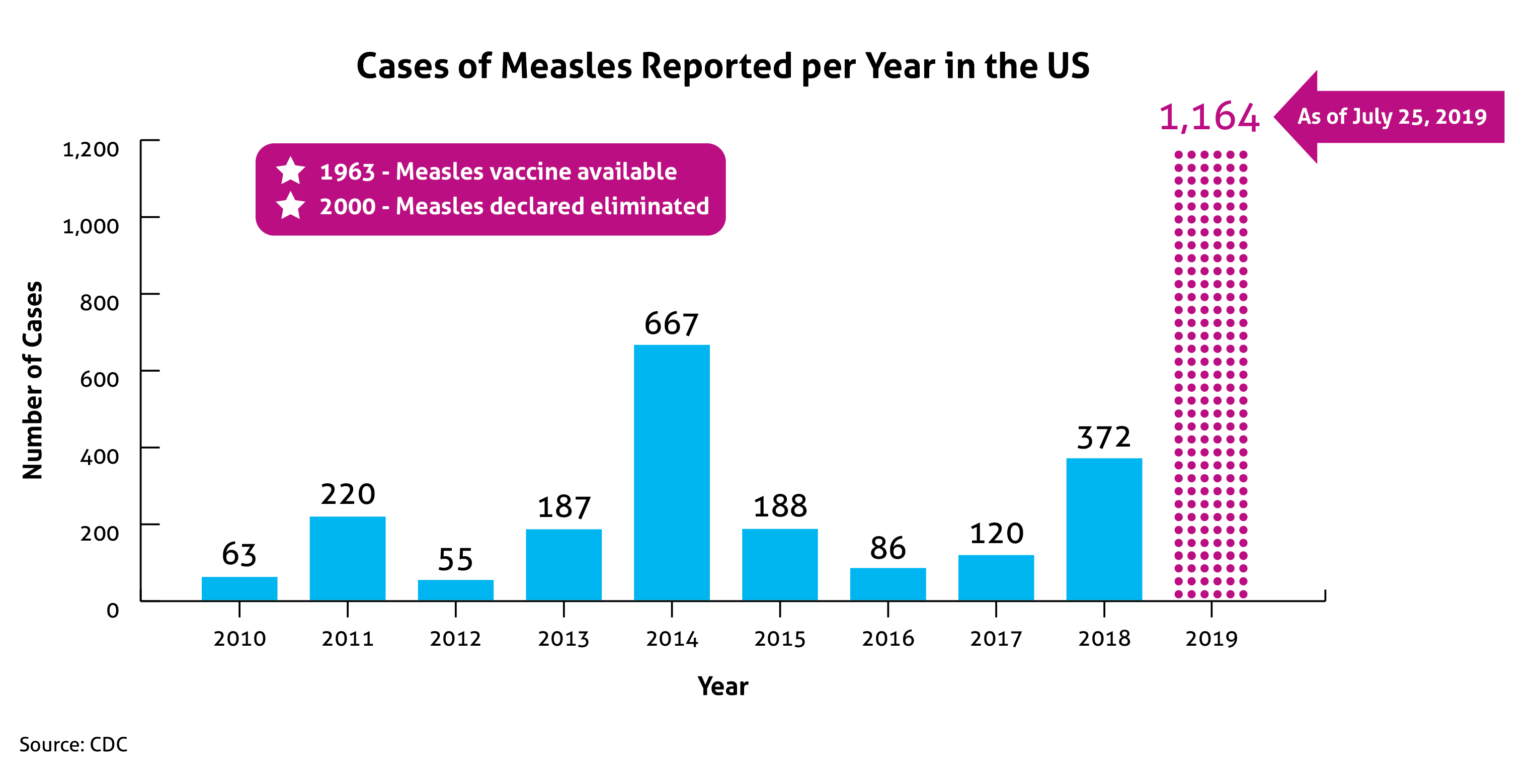Nearly 2 decades after measles was declared “eliminated” in the United States (US), we find ourselves in the midst of an unprecedented measles outbreak in the modern era of vaccination. As of July 25, 2019, a total of 1,164 active cases of measles have been confirmed in 30 states. As one of the most contagious human diseases, measles can lead to serious health complications such as pneumonia, encephalitis, and even death. Given its highly contagious nature, the measles resurgence has public health officials on high alert.
Once relegated to the history archives thanks to a widely effective immunization program, measles is an acute respiratory illness spread through coughing or sneezing. The virus can linger for up to 2 hours after an infected person leaves an area. Symptoms typically begin 1 to 2 weeks after a person becomes infected. High fever, cough, runny nose, and red/watery eyes are followed after a few days by the hallmark red rash. Patients are considered contagious from 4 days before and after the rash appears. It is so contagious that following exposure, about 90% of unprotected individuals will develop measles.
According to the Centers for Disease Control and Prevention (CDC), the measles outbreak has proliferated due to factors including international travel and unvaccinated individuals. Unfortunately, measles is common in many parts of the world, and Europe is experiencing an ongoing spike, which is contributing to the measles surge in the US. In late April 2019, the CDC reported that, of the 44 “imported measles” cases that came into the US this year, 34 cases were in primarily unvaccinated US residents traveling abroad. The majority of imported measles cases in the US have been from popular travel spots such as the Philippines, Ukraine, Israel, Thailand, Vietnam, and Germany. In June 2019, the CDC issued a Level 1 Global Measles Outbreak Notice, alerting US travelers to the current situation and reminding them to check their immunizations before traveling internationally. Regardless of destination, the CDC recommends visiting their “destinations” site to view valuable traveler’s health updates to safely plan for travel.
Insufficient measles vaccination coverage, the other culprit in this outbreak, has also been fueling US circulation of the disease. The majority of measles cases in the US have been among unvaccinated individuals. CDC statistics show that there are pockets of unvaccinated close-knit communities in certain US jurisdictions, such as in parts of New York, experiencing an outbreak. Measles spreads quickly through these populations, making it difficult to limit transmission. Personal and religious beliefs, complacency, and unproven risks thought to be associated with vaccines, are among the reasons behind vaccine hesitancy and avoidance, leading to undervaccination in vulnerable communities. Moreover, unfounded concerns regarding vaccines and autism, which have been refuted by scientific evidence, have also led to skepticism in select groups.
In the pre-vaccine era, an estimated 3 to 4 million people in the US contracted measles each year, resulting in significant deaths and hospitalizations. In modern times, a vaccine is the strongest weapon to combat measles. For best protection, 2 doses of the measles, mumps, and rubella (MMR) vaccine are recommended and are approximately 97% effective at preventing measles; 1 dose is roughly 93% effective. The MMR vaccine is part of routine childhood immunizations. Measles vaccine recommendations for all age groups, as well as for international travelers, are available on the CDC website.
The CDC deems a disease “eliminated” after 12 continuous months of no active transmissions. If the current outbreak, which started in New York in October 2018, is not contained by October 2019, the US risks losing its measles elimination status. Whether traveling abroad or enjoying a summer staycation, individuals and communities should guard against the measles virus. The best protection against the “21st century measles outbreak” is immunization. Armed with awareness, education, and appropriate vaccinations, this preventable disease can once again be banished to the history books.
Disclaimer: The content in this blog article is not a substitute for professional medical advice. For questions regarding any medical condition or if you are in need of medical advice, please contact your healthcare provider.





